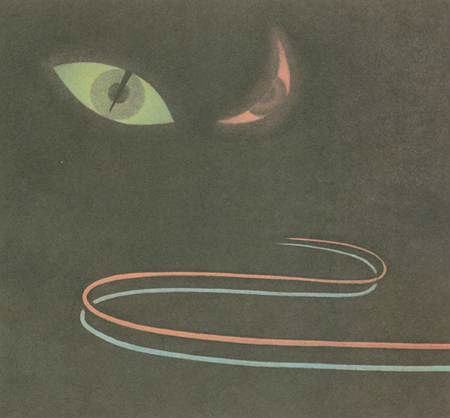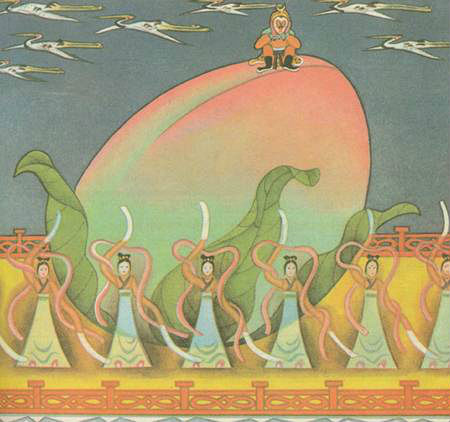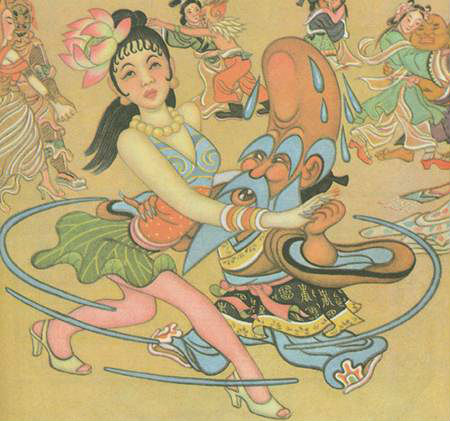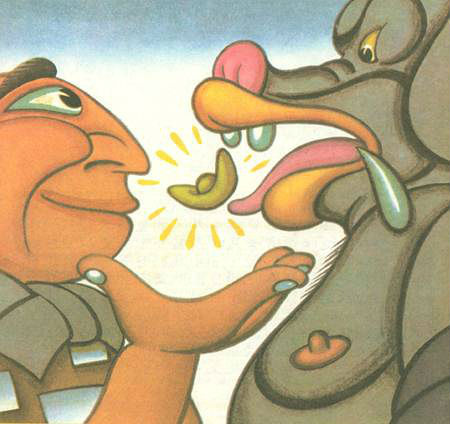This is the sixth chapter in my MA thesis, The Shanghai Manhua Society: A History of Early Chinese Cartoonists, 1918-1938, completed in December 2015 at the Department of Asian Studies at UBC. Since passing my defense, I’ve decided to put the whole thing up online so that my research will be available to the rest of the world. I’ve also decided to use Creative Commons Attribution-NonCommercial-NoDerivatives 4.0 International License, which means you can share it with anyone you like, as long as you don’t charge money for it. Over the next couple of days I’ll be putting up the whole thing, chapter by chapter. You can also download a PDF version here.
Over the years which followed its founding in 1926, the Manhua Society would come to be seen as forming an important part of the history of cartooning in China. Writing in the English language magazine ASIA Monthly some eight months after the outbreak of the second Sino-Japanese War in May, 1938, Jack Chen described the fate of the Manhua Society in vivid language:
Since this was not a fair weather art, it did not attract those in search of fame or fortune. On the contrary, it offered poverty and hard knocks. The history of the first group of cartoonists is typical. Out of ten members, one died with enough money to pay for his funeral; one joined the government and secured a job that kept him from doing embarrassing cartoons, one disappeared after publishing a particularly pointed anti-Kuomintang cartoon, six managed to hold together, to be joined by a seventh who had been in hiding for four years during the bitterest persecution of Leftists: after the fall of the Wuhan government in 1927 and the split of the united front between the Communist Party and the Kuomintang. Their survivors met [in 1934] at the home of their dead friend, whither that all unknowingly come on the same mission–to give him a regular funeral. Of the seven, three had steady jobs that paid fifty dollars gold a month, and they earned perhaps fifty more by extra work. These are the best paid cartoonists in China. The rest scrape along as best they can, editing, teaching, doing odd jobs. And yet–making cartoon history.[1]
While it is easy to identify the first Manhua Society member mentioned as Huang Wennong, who died of ruptured stomach ulcer on June 21, 1934, the others are less obvious. Clearly, Ji Xiaobo is the most likely candidate for having joined the government, and the six who held together most likely refers to Ye Qianyu, Zhang Guangyu, Zhang Zhengyu, Lu Shaofei, Ding Song, and Hu Xuguang or Zhang Meisun. Huang Wang seems to have been the only out-and-out leftist in the group, although the dates for going into hiding seem wrong, since he was active throughout 1927 and early 1928, and again in 1930, with a four year period of inactivity from 1931 to 1934. This corresponds with the crackdown against the League of Left-Wing writers, of which he was a member, in February, 1931. The author of the pointed anti-KMT cartoon is more difficult to identify, but it may have been a younger member of the staff at Shanghai Sketch II, such as Xuan Wenjie, or someone less directly connected, such as Huang Shiying.
↩
Birth of the Modern
Riding high on their success, on October 10, 1929, Shanghai Sketch Press 上海漫畫社, Zhang Zhengyu convinced his older brother to rename their press the China Fine Arts Periodical Press 中國美術刋行社and launch a second periodical, the monthly pictorial Modern Miscellany 時代畫報, to be co-edited by Zhang, and the modernist writer, Ye Lingfeng 葉靈鳳 (1905-1975).[2] Designed to compete with the wildly successful pictorial Young Companion 良友畫報, the inspiration for Modern Miscellany came after the Singaporean distributer for both Shanghai Sketch and Young Companion lost distribution rights to the latter. The distributor’s representative in Shanghai, Wang Shuyang (who had met Ye in 1925, when he interviewed him for the job at Three Friends Co.), approached Ye Qianyu and Zhang Zhengyu with this business opportunity, and Zhang managed to convince his older brother against of the urgings of their three partners. Shortly thereafter, Lang Jingshan, Hu Boxiang, and Zhang Zhenhou withdrew from the partnership in protest, forcing them to move their office from the church to an alley near the intersection of Nanjing Road and Zhejiang Road, just minutes from the Bund.[3]
As a result, the second issue of Modern Miscellany was delayed until late February of the next year, and the third issue was not published until May. To solve their cash flow problems, Zhang Guangyu and company announced in the June 7, 1930, issue of Shanghai Sketch that the publication would be merging with Modern Miscellany and the publication schedule changed to bimonthly.[4] On June 16, 1930, the first merged issue of Shanghai Sketch and Modern Miscellany was published, with the title shortened to Modern 時代.[5]
Meanwhile, in 1930 Ji Xiaobo and Ye Qianyu seem to have made steps toward burying the hatchet when Ji Xiaobo convinced the owner of Chenbao 晨報 [Morning Post] to launch a pictorial supplement which would serialize Ye Qianyu’s popular cartoon, Mr. Wang. Despite already working full-time as an editor at the bimonthly Modern Miscellany, Ye agreed, receiving 100 yuan per month for his strips, and two pin-up advertisements which the publisher requested in exchange for publishing the cartoon.[6] Despite Jack Chen’s sarcastic comment in late 1938 that “[Ji Xiaobo] joined the government and secured a job that kept him from doing embarrassing cartoons,” then, it seems possible that Manhua Society parted amicably, having served its purpose of launching the careers of its members.
Publication problems with Modern continued to persist, but as luck would have it, China Fine Arts Periodical Press had attracted the attention of the wealthy socialite and erstwhile poet, Shao Xunmei 邵洵美 (1906-1968), who was looking for an investment to change the declining fortunes of his large and profligate family.[7] In November, 1930 he officially joined the editorial staff of Modern, providing the necessary capital to have the magazine printed on the latest rotogravure presses rather than relying on the outdated copperplate etching that they had been using before.[8] A notice in Modern Issue 12 (Vol 1) announced
Improvement in Printing and Picture Plates
Starting with Issue 1, Vol. 2, we will begin using photogravure, plus two-color plates, three-color plates, seven-color plates, etc. The paper we use will also be changed to specially produced foreign-made photogravure paper, in what could be called a pioneering step in China.
印刷及圖版之改良
從二卷一期起改用影寫版印行並添加 雙色版、三色版、七色版等, 紙張亦改用特向外洋定造之影寫版專用紙, 可稱國內獨步[9]
As promised, the next issue of Modern, published on November 16, 1930, featured a large number of photographs, with much better contrast and fine detail. Over the next year however, due to the limited number of rotogravure presses in Shanghai at the time, Modern continued to suffer from delays, and quality declined as well. Finally, in the summer of 1931, Shao Xunmei managed to buy his own German-made rotogravure press for $50,000 US dollars, which was to be the foundation of his new venture, the Modern Press 時代印刷公司, and in the sixth issue (Vol. 2) of Modern, China Fine Arts Periodical Press announced that they would be taking a two month hiatus to set up their new press.[10] Renting a factory on Pingliang Road 平涼路in Yangpu district, between the Japanese controlled Hongkou district and the Huangpu River, Shao soon found himself cut off from his investment when this part of the International Settlement was occupied by Japanese troops arriving via gunboat in January, 1932.[11]
Continue reading →





















